COLUMN | Entertaining angels in these troubled times [Grey Power]

Impressive work by salvors and US engineers has restored full access to the Port of Baltimore, with the ill-fated containership Dali safely extracted from the wreckage of the bridge and alongside in the port she had left on March 26.
By every standard, it has been a spectacular operation, which few forecast could have been accomplished in such a short time, bearing in mind the devastation that locked the remains of the bridge onto the bow of the ship.
The port is now fully open for trade once again, although a range of eminently sensible precautions involving the use of escort tugs is required to make the passage between the port and the sea. It might be that lessons have had to be learned the hard way, and perhaps not surprisingly, a nation-wide study of other places where ships and bridges are in close proximity is under way.
“It suggests that there remain few mysteries left to unravel other than what precisely went wrong in the ship’s switchboard at such a crucial time.”
It might be assumed that very similar studies are taking place elsewhere in the world. It would be unbelievably stupid not to be taking a closer look at the risks, bearing in mind the shrinkage of safety envelopes around far larger ships and, if the reports of pilots and others are to be believed, the frequency of mechanical problems aboard ships they have boarded.
No one can be surprised that port state inspectors in various regions are also enhancing their inspections on areas that are relevant to power or steering loss in restricted waters, looking closely at logbooks and checking up that crews are familiar with their ship’s equipment and can appropriately react to emergencies such as blackouts. The US National Transportation Safety Board (NTSB) interim report into the Baltimore incident was published a week ago, with commendable speed and considerable clarity, focusing upon the electrical problems that saw the ship lose power as she approached the bridge.
As a study of the facts of the case, it suggests that there remain few mysteries left to unravel other than what precisely went wrong in the ship’s switchboard at such a crucial time. There is no attempt to attribute blame, which is not the job of NTSB investigators. The Federal Bureau of Investigation is apparently still probing the circumstances and will doubtless come to conclusions about any federal laws that might have been broken.
With the ship alongside, it might be that the crew consisting of 20 Indian nationals and one Sri Lankan will be treated rather more humanely, in a fashion that might be thought appropriate as “shipwrecked mariners”, which surely nobody can dispute that they are. They have surely suffered a considerable trauma with this appalling crash, but have been required to remain aboard to keep the job running, with no access to the shore.
Worse still, a few weeks into their confinement, the FBI investigators thought it reasonable conduct to remove all their mobile devices, leaving them unable to communicate with their loved ones or anyone else. Admittedly, a few days later, they were given temporary mobile devices, which of course would have had none of their personal data available.
“The treatment of a foreign shipwrecked crew in awful circumstances, possibly with legal charges facing some of them, does not reflect well on the US authorities.”
It is good to see that the treatment of the Dali crew, after their initial ordeal, has increasingly been the subject of adverse comment, prompting several commentators to ask whether a crew of US citizens would have been so confined. There are the usual mealy-mouthed official lines about visa restrictions, and the managers of the ship have been enabled to supplement the crew to help them out, and supply local ready meals to help out the exhausted cook.
The usual welfare organisations, such as the excellent Baltimore International Seafarers’ Center, have been in action, but unable to board the ship. And it is not being unreasonable to ask whether it was entirely appropriate for the crew to be aboard as the explosive charges blew much of the bridge off the bow in a spectacular essay in demolition engineering.
All in all, the treatment of a foreign shipwrecked crew in awful circumstances, possibly with legal charges facing some of them, does not reflect well on the US authorities. Those with longer memories might have recalled the truly awful treatment accorded to seafaring visitors in the years after 9/11 and the more recent way that the international seafarer was taken completely for granted during the pandemic.
It does little to encourage young people into the sea life, or the retention of the existing workforce as the manpower crisis becomes ever more acute. The biblical injunction for the treatment of strangers, “lest they be angels unawares”, comes to mind.







